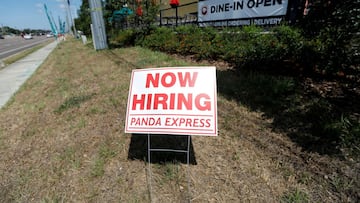How have the unemployment benefits ending in several states affected their employment rates?
New research shows that only minor increases in employment were seen in states that ended unemployment benefits compared to states that kept the payments.


As of July 2021, the national unemployment rate in the US was 5.4%, down significantly from the beginning of the pandemic. On average, the unemployment rate for each state and the District of Colombia was 1.5 percent higher than pre-pandemic levels.
On 6 September, federal pandemic-related unemployment benefits like the $300 topper sent in addition to state benefits will end, leaving millions without an income.
Last week the Bureau of Labor Statistics noted that unemployment claims fell for the fourth consecutive week, a positive sign that the surge in covid-19 cases has not led to a massive wave of lay-offs.
In May and June, twenty-six Governors, only one of which was a Democrat, called to end federal unemployment benefits claiming that they were leading to a labor shortage.
However, there is not much evidence to suggest that cutting the benefits early made a huge dent in enticing workers back into the labor market.
New research comparing employment in states that retrained and ended federal unemployment benefits
A new paper released by researchers at Columbia University, Harvard University, the University of Massachusetts Amherst, and the University of Toronto provide insights into how opportunities for workers in states that maintained and ended benefits differed.
🚨New study using new bank-transaction level data: What did ending pandemic UI do to jobs, income, spending?🚨
— Arindrajit Dube (@arindube) August 20, 2021
We find:
*Large drop in share receiving UI
*For every 8 losing UI, 1 found job by Aug
*Added earnings made up for only 7% of benefit loss
*Large 20% drop in spending
1/
Using real-time anonymous banking data, the authors attempted “to measure how this policy change affected the financial security and employment trajectories of unemployed workers with low incomes.”
The study only looked at the twenty-two states that cut benefits in June and perhaps will focus on those who ended payments in July in a future paper.
When comparing the number of unemployment recipients in states that cut benefits, the authors saw a decline in unemployment insurance (UI) payments of 35 percent by the end of July. These changes led to a “46% decline relative to the share of workers who would still be receiving unemployment benefits in the last week of July absent the policy change.”
Ease of findings a new job
While around 21.5% of the cohort had jobs by the end of July in Retain states, around 24.9% of the cohort did so in Withdrawal states, a 4.4 percentage point (20 percent) increase.
Early Withdrawal of Pandemic Unemployment Insurance: Effects on Earnings, Employment and Consumption (August 2021)
For workers in states where benefits were cut, only one out of eight workers who lost unemployment benefits found a new job. The group noted a “modest” increase in the probability that a worker who had lost benefits would find a job more quickly.
The increase in job gains -- 4.4% -- is far smaller than the 35 percent figure, representing the total number of workers who had their benefits cut early.
Changes in unemployment since states moved to cut benefits
Employment increases 10 percent in Hawaii from July 2020 to July 2021https://t.co/ZZJv5IeaSr pic.twitter.com/FgoStqrcxW
— BLS-Labor Statistics (@BLS_gov) August 24, 2021
Since May, states that have maintained the benefits have seen a decrease in unemployment of around .21 percent, while those that chose to end them saw a decrease of around half as much, .12 percent.
However, when looking at decreases compared to pre-pandemic levels, those that have cut benefits have made larger strides in inching closer to the unemployment rate seen in February 2020.
Related stories

2021 Child Tax Credit: how to change address with IRS tool
There are a total of nine states that recorded a lower unemployment rate compared to pre-pandemic levels:
- Montana
- Idaho
- Nebraska
- New Hampshire
- North Dakota
- Massachusetts
- South Dakota
- Kansas
- Utah.
Of those states, only two, Kansas and Massachusetts, are the only states that have not ended benefits early.
- Official unemployment rate
- Unemployment rate
- Unemployment compensation
- Covid-19 economic crisis
- Science
- Unemployment
- Coronavirus Covid-19
- Economic crisis
- United States
- Pandemic
- Coronavirus
- Recession
- Employment
- North America
- Economic climate
- Virology
- Outbreak
- Infectious diseases
- Diseases
- Microbiology
- America
- Medicine
- Work
- Economy
- Biology
- Life sciences
